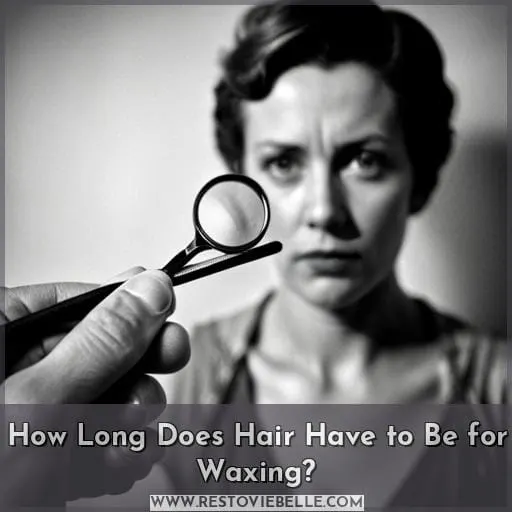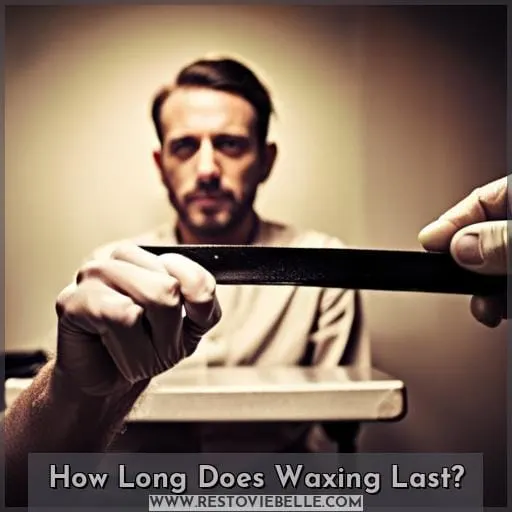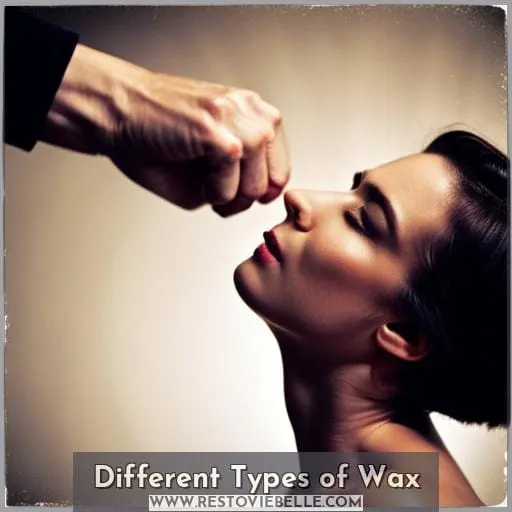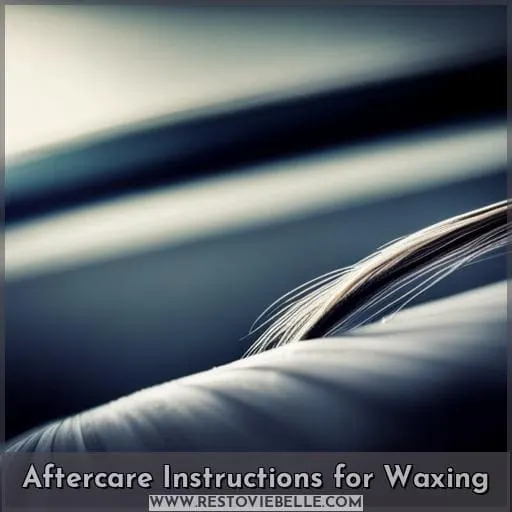This site is supported by our readers. We may earn a commission, at no cost to you, if you purchase through links.
 You’re ready to ditch the razor and embrace the smoothness of waxing. But before you book that appointment, let’s talk about hair length.
You’re ready to ditch the razor and embrace the smoothness of waxing. But before you book that appointment, let’s talk about hair length.
Did you know that there’s a minimum hair length for waxing? It’s true! For those stubborn strands to be effectively removed, they need to be at least 1/4 inch long.
So hold off on scheduling until your locks reach this sweet spot for optimal results and silky skin liberation awaits!
Table Of Contents
- Key Takeaways
- What’s the Right Hair Length for Waxing?
- How to Prepare for a Waxing Appointment
- How Long Does Waxing Last?
- Different Types of Wax
- Aftercare Instructions for Waxing
- Tips for Maintaining Waxing Results
- Frequently Asked Questions (FAQs)
- Can I wax my hair if it’s shorter than 1/4 inch?
- Is it necessary to grow out my hair for a certain period of time before waxing?
- What should I do if I accidentally shaved or tweezed in between waxes?
- Are there any alternative methods of hair removal besides waxing?
- How can I prevent ingrown hairs after waxing?
- Conclusion
Key Takeaways
- Waxing lasts for 4-6 weeks.
- The minimum hair length for waxing is 1/4 inch.
- The maximum hair length for waxing is 1/2 inch.
- Hair longer than 1/2 inch can be trimmed before your appointment for easier removal.
What’s the Right Hair Length for Waxing?
Wondering what the right hair length for waxing is?
When it comes to waxing, there’s a minimum and maximum hair length that you should keep in mind.
The minimum hair length for effective waxing is at least ¼ of an inch, while anything longer than ½ inch can be trimmed before your appointment.
Finding the sweet spot between these lengths will ensure that you get optimal results from your waxing session.
Minimum Hair Length for Waxing
To achieve the best results, your hair should be at least ¼ of an inch long for waxing.
This length allows the wax to adhere properly and remove the hair from the root.
If your hair is shorter than this, it may not effectively grab onto the hairs and can leave behind patches or cause ingrown hairs.
On the other hand, if your hair is longer than ½ inch, it can be trimmed before your appointment for easier removal.
Maximum Hair Length for Waxing
For the best results, your hair should be no longer than 1/2 inch when waxing. Here’s why:
- Hair shorter than 1/4 inch won’t adhere to the wax properly and can cause ingrown hairs.
- Longer hair is more painful to remove.
- Hair growth cycle affects how long you need to wait between waxes.
- Waxing with excessively long hair can be less effective and lead to discomfort.
How to Prepare for a Waxing Appointment
Now that you know the right hair length for waxing, it’s time to prepare for your waxing appointment.
- Avoid sweating, sunlight, and heat: These factors can make your skin more sensitive before a waxing session. Try to stay cool and dry in the 24 hours leading up to your appointment.
- Wear loose clothing: Opt for loose-fitting clothes on the day of your appointment as tight clothing can rub against freshly-waxed skin and cause irritation.
- Stick to a waxing schedule: It’s important to maintain regular appointments every 4-6 weeks for optimal results and smoother hair growth over time.
By following these preparation tips, you’ll be ready for an effective waxing session with minimal discomfort or complications.
How Long Does Waxing Last?
Waxing typically provides hair-free results for up to four to six weeks. The duration of waxing results can vary depending on individual factors such as hair growth rate and thickness.
Here is a breakdown of how long you can expect your waxing results to last:
- Light regrowth: After the first week or two, you may start noticing some fine hairs growing back.
2-4 weeks: At this stage, you’ll experience minimal regrowth with finer and softer hair texture.
2-8 weeks: The majority of people will see noticeable regrowth at around 2-8 weeks post-wax, but it should still be less dense compared to before waxing.
2-12 weeks: Some individuals may experience slower hair growth patterns resulting in longer-lasting smoothness for up to 12 weeks.
Keep in mind that these timeframes are approximate and can vary from person to person.
Different Types of Wax
When it comes to waxing, there are different types of wax that you can choose from.
Two common types are hard wax and soft wax.
Hard wax is applied in a thick layer and removed without the use of strips, making it ideal for sensitive areas like the face or bikini line.
Soft wax, on the other hand, is spread thinly over the skin and removed with cloth or paper strips.
Other options include hot waxes that require heating before application and cold waxes that come pre-coated on strips for convenience.
Hard Wax:
- Applied in a thick layer
- Removed without using strips
- Ideal for sensitive areas
Soft Wax:
- Spread thinly over the skin
- Removed with cloth or paper strips
Hot Waxes:
- Require heating before application
Cold Waxes:
-Come pre-coated on strips
Hard Wax Vs. Soft Wax
When choosing between hard wax and soft wax for your waxing appointment, it’s important to consider the differences in application and hair removal effectiveness.
Hard wax is a type of wax that hardens on its own without the need for strips, making it ideal for sensitive areas like the face and bikini area.
On the other hand, soft wax requires strips to be applied over it before removing hair.
Both types have their advantages and disadvantages when compared to sugaring, hot waxes, cold waxes or Nair products.
Hot Wax Vs. Cold Wax
To determine the best type of wax for your hair removal needs, consider the difference between hot wax and cold wax.
Hot wax is heated to a high temperature, making it stickier and more effective at removing coarse hair. It can be slightly more painful than cold wax but provides longer-lasting results.
Cold wax comes pre-applied on strips and doesn’t require heating. It’s less sticky and may not remove all hairs as effectively as hot wax but is generally less painful to use.
Other Waxing Options
Looking for alternatives to waxing? What’re some other options you can consider for hair removal? Here are four alternative methods to waxing that you may want to explore:
- Sugaring: A natural method of hair removal using a sugar paste.
- Threading: An ancient technique that uses twisted threads to remove unwanted hair.
- Epilation: The process of removing hair from the root using an electronic device.
- Laser Hair Removal and Electrolysis: Permanent solutions for long-term reduction or elimination of unwanted body hair.
[ADDITIONAL INFORMATION]:
If given more words, additional information on each method could be provided, including their benefits, drawbacks, and how they compare with traditional waxing techniques.
Aftercare Instructions for Waxing
To ensure proper healing and maintenance of your waxed skin, it’s important to follow these aftercare instructions.
After your waxing session, avoid:
- Sweating
- Excessive sunlight exposure
- Heat
These factors can irritate the freshly waxed skin and cause discomfort or even infection.
Additionally, wearing loose clothing during this time allows your skin to breathe and reduces friction on the treated area.
To prevent ingrown hairs, exfoliate regularly starting a few days after your waxing appointment. This helps remove dead skin cells that can block hair follicles from growing properly.
You may also consider using products specifically designed for treating ingrown hairs like an ingrown hair cream or serum recommended by a professional esthetician or dermatologist.
Tips for Maintaining Waxing Results
To maintain waxing results, keep exfoliating and moisturizing your skin between appointments.
Here are three tips for maintaining waxing results:
- Exfoliate regularly: Use a gentle scrub or exfoliating brush to remove dead skin cells from the surface of your skin. This will help to prevent clogged hair follicles and reduce the chance of ingrown hairs.
- Moisturize daily: Apply a hydrating lotion or oil after showering to keep your skin moisturized. Dry, flaky skin can make it more difficult for the wax to adhere properly, leading to less effective hair removal.
- Avoid sweating: After getting waxed, try not engage in activities that cause excessive sweating for at least 24 hours. This includes avoiding intense workouts or sitting in saunas as sweat can irritate freshly-waxed areas.
Remember also wear loose clothing during this period To allow proper airflow on the treated area.
By following these tips, you can prolong the smoothness of your waxed areas between appointments.
Frequently Asked Questions (FAQs)
Can I wax my hair if it’s shorter than 1/4 inch?
To ensure a successful waxing experience, your hair should be at least 1/4 inch long.
If it’s shorter than that, the wax may not adhere properly and could leave behind hairs or cause ingrown hairs.
Is it necessary to grow out my hair for a certain period of time before waxing?
To ensure a successful waxing experience, it’s necessary to grow out your hair for a certain period of time.
Hair should be at least 1/4 inch long, or around the size of a grain of rice, before waxing.
What should I do if I accidentally shaved or tweezed in between waxes?
Accidentally shaved or tweezed? Oh no! Well, my friend, you’ll have to wait for your hair to grow back before waxing.
Are there any alternative methods of hair removal besides waxing?
Yes, there are alternative methods of hair removal besides waxing.
Some options include:
- Sugaring
- Shaving
- Epilation
- Threading
- Laser hair removal
Each method has its own benefits and considerations to keep in mind for effective results.
How can I prevent ingrown hairs after waxing?
To prevent ingrown hairs after waxing, you can:
- Exfoliate regularly
- Moisturize your skin in between waxing visits
- Ask a waxing specialist for product recommendations to treat and prevent ingrown hairs.
Conclusion
Ultimately, the right hair length for waxing is crucial for optimal results and smooth, silky skin. While there’s a minimum hair length of 1/4 inch, it’s important to note that there’s also a maximum hair length for waxing.
To prepare for a waxing appointment, make sure your hair is within the recommended length range. Different types of wax can be used, such as hard or soft wax, hot or cold wax, depending on your preferences and needs.
Following proper aftercare instructions and maintaining waxing results will help you achieve long-lasting hair-free skin.












